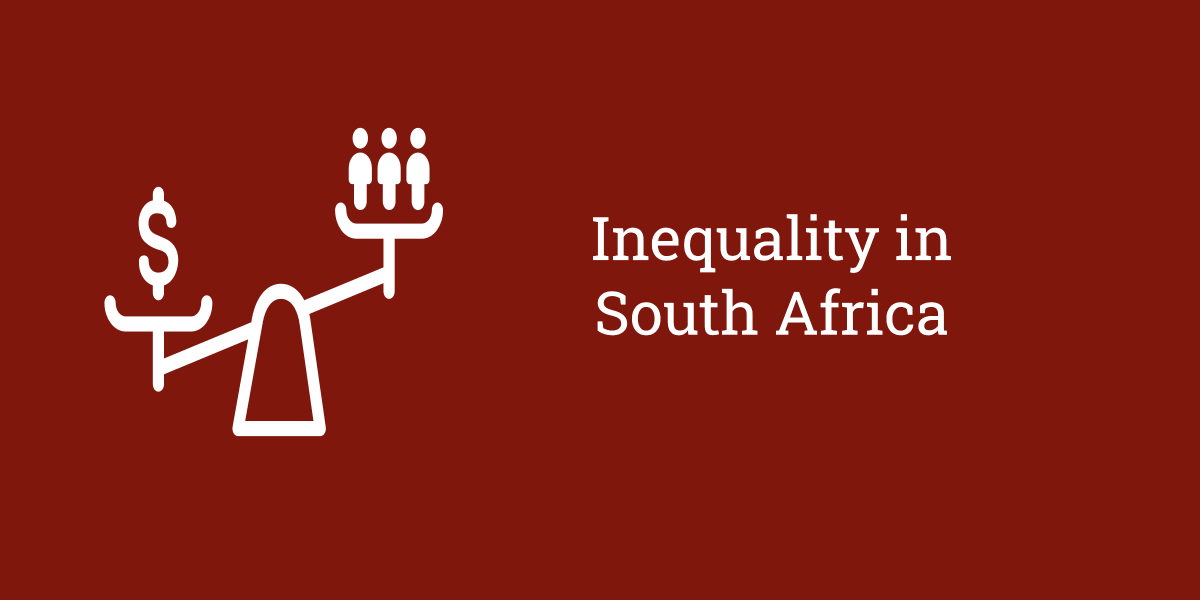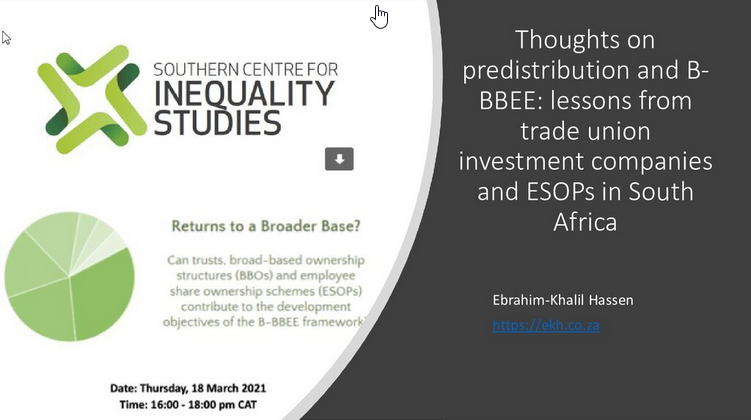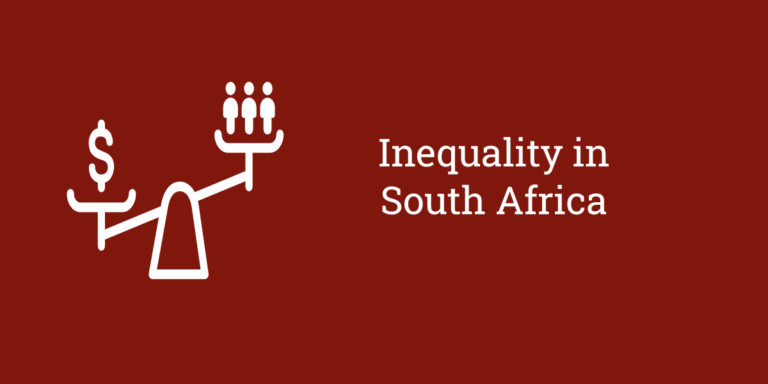The fisticuffs around the concept of a “Second Transition” have defined debates in the run-up to the African National Congress (ANC) national policy conference. The drafters of The Second Transition: Building a National Democratic Society and the Balance of Forces in 2012 argue, “The time has come to build a new national consensus for the next 50 years. The consensus should lay the basis for a second transition of social and economic transformation, building on the foundation of our political transformation.”
The debate is layered with palace politics, but also pertinent questions on how a Second Transition relates to the creation of an egalitarian society where race, class and gender do not determine the opportunities and outcomes that people have. To achieve this, the ANC needs to facilitate extraordinary transitions by ordinary people.
Let us take the case of “Thabo” to understand why we remain one of the most unequal societies in the world as well as why we now have such high levels of long-term unemployment.
Thabo is a 26-year-old adult who has never been formally employed. His matriculation certificate was meant to be a passport to the world of work, but he found himself with too few points to enter university and without experience to find work. Thabo is part of the generation of young South African adults who have never worked, and as the National Planning Commission’s diagnostic report bleakly states, is unlikely to ever find work.
Thabo’s life chances were shaped not only by being born into a poor black family, but also by the fact that he attended a local school within a schooling system that is exceptionally weak. He also happens to be part of a demographic trend that has been called the “lost generation”. But Thabo tries to get by as an informal trader – what the literature on entrepreneurship calls a “necessity entrepreneur”. He trades, not in pursuit of a broader vision, but to meet his daily needs.
Thabo would however remind us that he has taken advantage of business development support and even completed a business plan, but that he simply cannot get a loan to get his business started. Instead, he has made a start and deposits some money every month into a bank account — whatever he can in the hope that someday he will have enough. In between he knows there are school uniforms to pay for, taxi rides to job interviews and inevitably some family crisis that he needs to respond to.
He has heard of a stokvel in the area and has friends that belong to a cooperative. He thinks this might be a better way to save. For Thabo, the time horizon is often just the next day’s food. It’s a far cry from the 50-year horizon suggested in the Second Transition. The quote from Keynes, “In the long run, we are all dead,” loses its witty edge.
The ANC’s policy discussion documents recognise Thabo’s plight. In between the pages of the various discussion documents are various proposals that may help him make the transition, such as, delivering some kind of support to find a job (either through the heavily contested wage subsidy or a work seekers grant), improvements in access to vocational training as well as extending the social wage, are all mechanisms that might allow him to make the transition from unemployed to employed.
The task at hand is beguiling – first make a decision and second, to implement it. Yet if one goes back a decade to the Stellenbosch conference of the ANC, virtually the same solutions were being proposed and debated. The deeper task then is to understand why the best policy intentions have not materialised in practice. To make it clearer, if Thabo were a Brazilian or Indian unemployed young adult he would be able to access a range of services and grants that could work. In Brazil, he could access a universal social grant combined with job seeker training. In India he could register to be part of the Employment Guarantee Scheme.
Thabo buys his goods from a successful wholesaler that could be hailed as an entrepreneur who understands the “bottom of the pyramid”. Adam is a successful trader and argues that he helps people put bread on the table. Adam’s business model is simple. He buys in bulk and sells smaller quantities to informal traders. Adam is considering opening up a light industrial factory to produce the snacks he sells to vendors, as this would be profitable in addition to the fact that the wholesale game is getting “overtraded”.
In planning the factory, Adam realises that it is cheaper to buy equipment from Beijing than from Benoni. As a result, he is looking into getting an import license. The local manufacturer tells him that the cost of steel in South Africa is very expensive and that “unlike the Chinese government, President Zuma does not provide us with subsidies.” The manufacturer, trading as “Koos Engineering”, adds that his costs are higher because there is only demand for about 10 sweet making machines. Labour costs are also going up each year, he complains.
Here again questions of support for small-scale industry and import parity pricing have been on the agenda for almost the entire two decades since South Africa’s democratisation. The Industrial Policy Action Plan and the New Growth Path provide something of a beginning to tackle these areas of intervention. These are nascent programmes that offer much for economic development, even if they don’t really understand what makes Thabo, Adam or Koos the entrepreneurs they are.
The short, sharp simple task is this: take the Integrated Small Business and Entrepreneurship Strategy and do a simple assessment of what has been implemented, what the successes have been, and ask tough questions about why other areas have failed or not been undertaken.
For Adam the transition up the supply chain – to run a factory – could be assisted through the introduction of industrial parks and the sharing of equipment, thus reducing start-up costs. He could also benefit from a tax incentive that links his production as a small producer into larger value chains.
For Koos bringing down the costs of inputs in the form of steel not only reduces the costs of production, but also instantly makes his products competitive and with continued servicing could provide a new lease for his business and the jobs that it creates. Supporting these transitions would be relatively easy to accomplish and comparatively cheap.
Importantly, the entire case presented thus far does not include women in the value chain, which broadly reflects the lack of female business owners in the South African economy. The primary means of exchange is capitalist and individualistic, whilst the ANC is supportive of more social forms of ownership. Here again, policy remains in place.
The Second Transition thus misses the mark because each day small steps can be taken to make our economy more inclusive. It could simply be a 50-point checklist that is updated each month to gauge progress with enough information to ensure progress is being made. This is the glue that links the big conceptual ideas of an egalitarian society and an activist state, with the material conditions faced by the little guys in the economy – the unemployed and small businesses.
In this sense, the call for a 50-year vision to undertake a Second Transition is misplaced, but not only in terms of the time horizon. Problematically, it suggests that consensus is needed when what is actually needed to make the economy work to create social mobility, is a government unafraid to take a stand for and with the little guy, and to use its power to shape economic relations that create jobs and opportunity. This is not the work of building consensus; it is the work of challenging and transforming existing power relations in the economy. A more ambitious programme would be to claim the concept of a social revolution in a short space of time, which manifests itself strongly in centre left governments in Latin American and Asian countries.
Programmatic expression would lie in three major areas. First, it is about ensuring that young adults receive support to make the transition into work or ownership of businesses. Strategies such as the Community Works Programme and the proposed job seekers grant are examples of the strategies that can be expanded in the next year.
Second, the relationship between small and big businesses requires greater exploration. This could involve tax incentives, but more importantly requires government to tackle import parity pricing in the steel and agricultural sectors, as well as improving Internet capacity and access in South Africa.
Third, building ownership models that are more social and democratic, such as co-operatives, is an important area of experimentation that must be closely monitored to learn from failures as well as support success stories.
Taken together, these three areas could provide the foundation for a 10-year intervention that results in meaningful social transformation. It would provide the little guys in our economy with the support needed to make the smaller transitions by removing the structural limitations that hamper these transitions. The task is thus more demanding than setting a 50-year vision; it is about setting the agenda for social revolution within the next decade.
This article was first published under creative commons license on South African Civil Society Information Service website.


